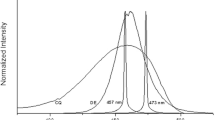Abstract
A diode-pumped solid state (DPSS) laser emitting at 473 nm was used to test its influence on the degree of polymerization of composite resins. Eight composite resins were chosen and light cured with three different light-curing systems [a quartz–tungsten–halogen (QTH) lamp-based unit, a light-emitting diode (LED) unit, and a DPSS laser]. Polymerization shrinkage and color change in specimens were measured. According to the statistical analysis, each light-curing system produced a significantly different value of maximum polymerization shrinkage. In most specimens, the DPSS laser induced the least polymerization shrinkage. After being immersed in distilled water for 10 days, specimens light-cured by the DPSS laser had undergone less color change than those cured by the other units. In conclusion, the DPSS laser induced better or similar polymerization in terms of polymerization shrinkage and color change in composite resins compared with those of the QTH lamp-based and LED units.
Similar content being viewed by others
References
Cavalcante LM, Peris AR, Ambrosano GM, Ritter AV, Pimenta LA (2007) Effect of photoactivation systems and resin composite on the microleakage of esthetic restorations. J Contemp Dent Pract 8:70–79
Pradhan RD, Melikechi N, Eichmiller F (2002) The effect of irradiation wavelength bandwidth and spot size on the scra** depth and temperature rise in composite exposed to an argon laser or a conventional quartz-tungsten-halogen source. Dent Mater 18:221–226. doi:10.1016/S0109-5641(01)00037-9
Soares LE, Martin AA, Pinheiro AL, Pacheco MT (2004) Vickers hardness and Raman spectroscopy evaluation of a dental composite cured by an argon laser and a halogen lamp. J Biomed Opt 9:601–608. doi:10.1117/1.1688811
Asmussen E, Peutzfeldt A (2005) Temperature rise induced by some light emitting diode and quartz-tungsten-halogen curing units. Eur J Oral Sci 113:96–98. doi:10.1111/j.1600-0722.2004.00181.x
Bouillaguet S, Caillot G, Forchelet J, Cattani-Lorente M, Wataha JC, Krejci I (2005) Thermal risks from LED-and high-intensity QTH-curing units during polymerization of dental resins. J Biomed Mater Res B Appl Biomater 72B:260–267. doi:10.1002/jbm.b.30143
Knezevic A, Tarle Z, Meniga A, Sutalo J, Pichler G (2005) Influence of light intensity from different curing units upon composite temperature rise. J Oral Rehabil 32:362–367. doi:10.1111/j.1365-2842.2004.01418.x
Oberholzer TG, Du Preez IC, Kidd M (2005) Effect of LED curing on the microleakage, shear bond strength and surface hardness of a resin based composite restoration. Biomaterials 26:3981–3986. doi:10.1016/j.biomaterials.2004.10.003
Telford W, Murga M, Hawley T, Hawley R, Packard B, Komoriya A, Haas F, Hubert C (2005) DPSS yellow-green 561-nm lasers for improved fluorochrome detection by flow cytometry. Cytometry A 68A:36–44. doi:10.1002/cyto.a.20182
Kwon YH, Jang CM, Shin DH, Seol HJ, Kim HI (2008) The applicability of DPSS laser for light curing of composite resins. Lasers Med Sci 23:407–414. doi:10.1007/s10103-007-0496-0
Knezevic A, Ristic M, Demoli N, Tarle Z, Music S, Negovetic Mandic V (2007) Composite photopolymerization with diode laser. Oper Dent 32:279–284. doi:10.2341/06-79
Watts DC (2005) Reaction kinetics and mechanics in photo-polymerised networks. Dent Mater 21:27–35. doi:10.1016/j.dental.2004.10.003
Asmussen E, Peutzfeldt A (1999) Direction of shrinkage of light-curing resin composites. Acta Odontol Scand. 57:310–315 doi:10.1080/000163599428535
Oberholzer TG, Pameijer CH, Grobler SR, Rossouw RJ (2003) The effect of different power densities and method of exposure on the marginal adaptation of four light-cured dental restorative materials. Biomaterials 24:3593–3598. doi:10.1016/S0142-9612(03)00211-4
Barros GK, Aguiar FH, Santos AJ, Lovadino JR (2003) Effect of different intensity light curing modes on microleakage of two resin composite restorations. Oper Dent 28:642–646
Rahiotis C, Affodite CR, Loukidis M, Vougiouklakis G (2004) Curing efficiency of various types of light-curing units. Eur J Oral Sci 112:89–94. doi:10.1111/j.0909-8836.2004.00092.x
Kemp-Scholte CM, Davidson CL (1988) Marginal sealing of curing contraction gaps in class V composite resin restorations. J Dent Res 67:841–845
Lai JH, Johnson AE (1993) Measuring polymerization shrinkage of photo-activated restorative materials by a water-filled dilatometer. Dent Mater 9:139–143. doi:10.1016/0109-5641(93)90091-4
Davidson CL, Feilzer AJ (1997) Polymerization shrinkage and polymerization shrinkage stress in polymer-based restoratives. J Dent 25:435–440. doi:10.1016/S0300-5712(96)00063-2
Taira M, Urabe H, Hirose T, Wakasa K, Yamaki M (1988) Analysis of photo-initiators in visible-light-cured dental composite resins. J Dent Res 67:24–28
Shortall AC (2005) How light source and product shade influence cure depth for a contemporary composite. J Oral Rehabil 32:906–911. doi:10.1111/j.1365-2842.2005.01523.x
Sidhu SK, Ikeda T, Omata Y, Fujita M, Sano H (2006) Change of color and translucency by light curing in resin composites. Oper Dent 31:598–603. doi:10.2341/05-109
Ferracane JL, Moser JB, Greener EH (1985) Ultraviolet light-induced yellowing of dental restorative resins. J Prosthet Dent 54:483–487. doi:10.1016/0022-3913(85)90418-4
Hirabayashi S (1987) The influence of monomer composition and filler on light permeability and polymerization of visible light-cured composite resin. J J Dent Mater 6:481–495
Acknowledgments
This study was supported by a Medical Research Institute Grant 2006-05, Pusan National University.
Author information
Authors and Affiliations
Corresponding author
Rights and permissions
About this article
Cite this article
Jung, YH., Cho, BH., Nah, KS. et al. Effect of diode-pumped solid state laser on polymerization shrinkage and color change in composite resins. Lasers Med Sci 25, 339–343 (2010). https://doi.org/10.1007/s10103-009-0644-9
Received:
Accepted:
Published:
Issue Date:
DOI: https://doi.org/10.1007/s10103-009-0644-9




